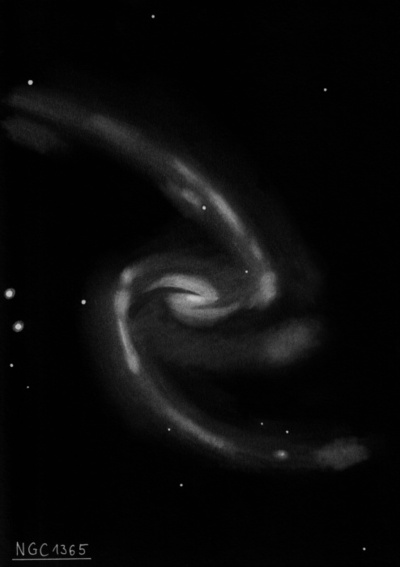
James Dunlop discovered NGC 1365 = D 562 = h2552 on 2 Sep 1826 with his 9" reflector from Parramatta and described "a pretty large faint round nebula, about 3 1/2' diameter, gradual slight condensation to the centre, very faint at the margin." He made two observations though his published position is off by 10 tmin in RA. By examining Dunlop's original papers, Glen Cozens found a copying error and Dunlop's handwritten position falls ~8' E of NGC 1365.
John Herschel independently discovered NGC 1365 on 28 Nov 1837 and described "A very remarkable nebula. A decided link between the nebula M 51 and M 27. Centre very bright; somewhat extended; gradually very much brighter to the middle; a 13th magnitude star near the edge of the halo involved. The area of the halo very faint; general position of the longer axis 20.8 degrees. whole breadth = 3'. See Pl. IV. fig. 1." The next night he made a second observation and logged "very bright, extended, resolvable nucleus; or has 2 or 3 stars involved; the preceding Arc is the brighter. I think the oval is in some degree filled up to the south." Based on his size estimate, JH may have only observed the central region. The NGC attributes JH with the discovery.
Joseph Turner observed and sketched a pair of dramatic spiral arms, central bar and core as a "Z" shaped figure using the 48-inch Great Melbourne Telescope on 2 Dec 1875 (unpublished lithograph plate II, figure 10), as well as Albert Le Sueur on 30 Jan 1870 (plate VII, figure 84).
200/250mm - 8" (1/1/84): fairly bright, fairly large, bright core, diffuse halo, broad concentration.
8" (9/25/81): moderately large, elongated, gradually brighter core.
300/350mm - 13.1" (12/22/84): bright, elongated core, large, 3' diameter, very diffuse outer halo. Member of the Fornax I cluster.
400/500mm - 18" (12/30/08): although a pale imitation of the view from Australia, with careful viewing at 175x the spiral arm attached at the west end of the central bar was faintly visible sweeping to the NNE for ~3' in length. The counterpart on the SE side was not seen.
600/800mm - 24" (11/18/12 - Magellan Observatory, Australia): viewed SN2012fr, a type Ia supernova, as a mag 12 star situated just 2" west and 52" north of the center of NGC 1365.
24" (4/5/08 - Magellan Observatory, Australia): this is the best visual barred spiral in the sky and although it was only at 33? elevation (well past the meridian), the view was stunning at 200x with its long sweeping arms making a slashing cosmic "Z" in the eyepiece. I was also surprised by the structure in the fairly small, extremely bright core that is embedded in the 3' E-W bar. On the north edge of the mottled core, a very short, hooking appendage extended towards the northeast with a fainter counterpart on the southwest end. This gave the small core the appearance of a tiny barred spiral! At the west end of the bar a bright arm emerges, dramatically sweeping back to the NNE (sharp 110? angle) beyond a mag 13 star that is situated near the 1/3 mark of its total length. The counterpart on the east end of the bar shoots to the southwest, reaching a faint star at its end. The total distance between the tips of the arms is roughly 10'.
900/1200mm - 48" (10/22/11): stunning view of this huge, barred spiral with the full extent of the long, graceful arms clearly visible and a great deal of structure. The very bright bar runs nearly 3' WSW-ENE and contains an extremely bright core that increases to a striking knotty nucleus that is sliced by a dust lane running SW to NE. The dust lane creates a mini spiral in the center with a bright elongated section south of the lane that has an "arm" attached at its northeast end that curls to the southwest. The section of the nucleus north of the lane appears as a small but brighter arm, gently curving from SW to NE.
The main northern spiral arm is attached at the west end of the bar and has a bright, mottled "knot" as it emerges from the bar and heads north-northeast. This knot contains the HII regions #23-25 from Paul Hodge's 1969 "HII Regions in Twenty Nearby Galaxies" (ApJS, 18, 73). It was also the site of SN 2001du, a supernova discovered visually by Robert Evans. This arm dims a bit and then brightens along a 1' strip (containing #19) just northwest of a superimposed mag 13.5 star. The arm then dims significantly but can be easily traced a total length of 6.5', ending just southeast of a mag 13.5-14 star.
The main southern arm emerges on the east-northeast end of the bar as a brighter patch or OB association that contains #2-3, matching the west end. A group of stars is just beyond this patch to the east. The arm extends ~6.5' SW and is bordered by several stars; a mag 14.5 star is on the south edge before the middle of the arm, a mag 16 star 1.3' due south of this star and two mag 15/16 stars are on the inside (northern edge) beyond the middle of the arm. A very small, very faint knot is near the southwest tip of the arm. The arm dims significantly at this point but bends and continues another 2' NW.
Notes by Steve Gottlieb